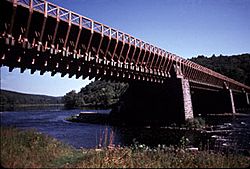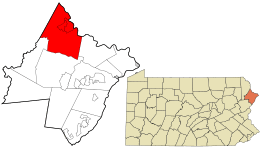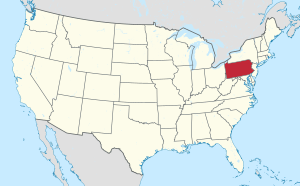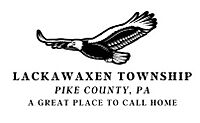Lackawaxen Township, Pike County, Pennsylvania facts for kids
Quick facts for kids
Lackawaxen Township
|
||
|---|---|---|
|
Township
|
||

Roebling's Delaware Aqueduct, spanning the Delaware River
|
||
|
||
| Motto(s):
"A Great Place to Live, Work, and Play"
|
||

Location in Pike County and the state of Pennsylvania.
|
||

Location of Pennsylvania in the United States
|
||
| Country | United States | |
| State | Pennsylvania | |
| County | Pike | |
| Founded | 1770 | |
| Area | ||
| • Total | 81.24 sq mi (210.41 km2) | |
| • Land | 78.44 sq mi (203.16 km2) | |
| • Water | 2.80 sq mi (7.25 km2) | |
| Elevation | 1,283 ft (391 m) | |
| Population
(2020)
|
||
| • Total | 5,066 |
|
| • Density | 64.66/sq mi (24.97/km2) | |
| Time zone | UTC-5 (EST) | |
| • Summer (DST) | UTC-4 (EDT) | |
| Area code(s) | 570 | |
| FIPS code | 42-103-40776 | |
| Website | Lackawaxen Township, Pennsylvania | |
Lackawaxen Township is the biggest and most northern township in Pike County, Pennsylvania. In 2020, about 5,066 people lived there. The Delaware River forms its eastern border. The Lackawaxen River also meets the Delaware River in Lackawaxen Village. Two well-known housing areas, Fawn Lake Forest and Masthope Mountain, are found in the township.
Contents
History of Lackawaxen Township
Early Settlement and Native American Presence
The area was settled by European-Americans in 1798. They named it Lackawaxen, which means "swift waters" in the Lenape language. This name comes from the Lackawaxen River, which flows through the township for twelve miles.
Before the European settlers arrived, both the Lenape and Seneca tribes lived here. They used the land mainly for hunting. They did not have large villages in the area. Tools, pottery pieces, and bone fragments from these Native American groups have been found at old campsites.
The first permanent European settlers were Jonathan Conkling and John Barnes. They built their homes in 1770. In 1779, a battle called the Battle of Minisink took place. About 40 to 50 European settlers were killed. This happened during a fight with a group of Iroquoian people and Loyalists. They were led by Colonel Joseph Brant, a Mohawk leader who fought for the British.
Logging and Canals
In the early 1800s, cutting down trees for wood, called logging, was the main business. Workers would float huge amounts of lumber down the Delaware River. This wood went to markets in cities like Easton and Trenton.
In 1829, the Delaware and Hudson Canal started operating. This canal connected Honesdale, Pennsylvania, to Kingston, New York. At that time, the canal company was one of the largest private businesses in the country. They built 28 locks in Lackawaxen Township alone. These locks helped raise the canal's water level by about 85 meters (278 feet). Some of these old locks can still be seen today. Some lock houses are now private homes.
Roebling's Delaware Aqueduct was built in 1848. It was designed by John A. Roebling, who also designed the famous Brooklyn Bridge. This aqueduct was part of the canal system. Today, it is protected as a National Historic Civil Engineering Landmark and a National Historic Landmark by the National Park Service (NPS).
The canal helped connect New York City to rich coal areas. These areas included Carbondale, Wilkes-Barre, and Scranton. Coal was important for factories and for heating homes.
Railroads and Tourism
In 1848, the New York and Erie Railroad was built through the area. Even though the canal kept working for another fifty years, railroads eventually became more popular. They made canals less important for transportation.
The railroad also brought tourism to Lackawaxen. The beautiful countryside of the upper Delaware Valley became a popular place for people from cities to visit. Train stations were built at Lackawaxen, West Colang, and Mast Hope. Fancy resort hotels soon opened nearby. These hotels often offered guides for fishing, hiking, and riding.
Bluestone Quarrying and Famous Residents
Bluestone quarrying became a big business in the mid-1800s. Bluestone was used a lot to build local buildings and sidewalks.
From 1905 to 1918, a famous western author named Zane Grey lived in Lackawaxen. He lived there with his wife and children. His early stories were often about his fishing trips along the upper Delaware River. The home where the Grey family lived from 1914 to 1918 is now a museum. It is called the Zane Grey Museum and is part of the Upper Delaware Scenic and Recreational River area. Zane Grey is buried in the local Union Cemetery.
A doctor named Orvan Hess was also born in Lackawaxen.
Geography of Lackawaxen Township
Lackawaxen Township is a beautiful area within the Upper Delaware River National Park. It is about a two-hour drive from New York City. It is also located about 35 kilometers (22 miles) northwest of Milford. Milford is the county seat of Pike County.
According to the United States Census Bureau, the township covers a total area of about 210.4 square kilometers (81.2 square miles). Most of this, about 203.2 square kilometers (78.4 square miles), is land. The remaining 7.25 square kilometers (2.8 square miles) is water.
Population and People
| Historical population | |||
|---|---|---|---|
| Census | Pop. | %± | |
| 2000 | 4,154 | — | |
| 2010 | 4,994 | 20.2% | |
| 2020 | 5,066 | 1.4% | |
| 2021 (est.) | 5,215 | 4.4% | |
In 2010, there were 4,994 people living in Lackawaxen Township. There were 2,099 households and 1,453 families. The population density was about 24.6 people per square kilometer (63.7 people per square mile). There were 4,580 housing units in the township.
Most of the people living in the township were White (94.2%). There were also African American (2.7%), Native American (0.2%), and Asian (0.6%) residents. About 4.2% of the population was Hispanic or Latino.
About 22.1% of households had children under 18 years old. Most households (58.3%) were married couples living together. About 26% of all households were made up of single individuals.
The average age of people in the township was 48.8 years. About 19.1% of the population was under 18 years old. About 22.4% of people were 65 years or older.
See also
 In Spanish: Municipio de Lackawaxen para niños
In Spanish: Municipio de Lackawaxen para niños


